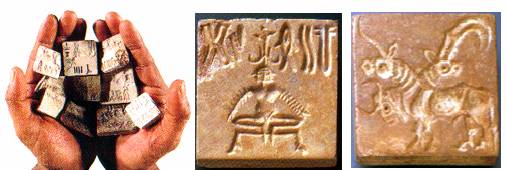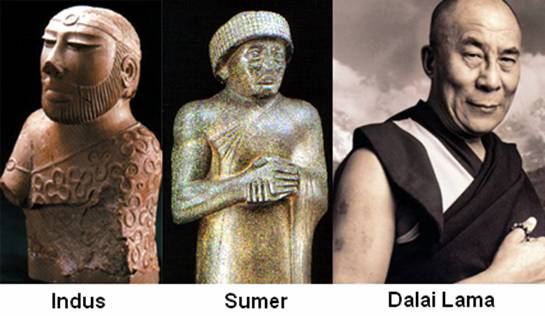|
Dating ancient
cultures has been one of the most demanding tasks of the
archeologists. The Indus Valley culture is estimated to have
flourished between 2500 to 1500 BC
(1)
but its origin is
unknown. The two most important cities of the Indus Valley are
Harappa and Mahenjo-Daro shown on the map of Chapter 16,
The South-West Expansion. This region is presently within
Pakistan but was once part of India. The root word “in”
forming both India and Indus means
descend in
Turkish, an appropriate selection for the name of a region
where central Asiatic Uighur tribes descended. In Latin, Old
German and in English “in” implies a similar meaning
indicating location or position within limits. Such root words
have their origin in the Proto-language of Central Asia and
should not be labeled as resulting from pure coincidence.
The Indus
civilization left behind a multitude of seal molds and tokens
made chiefly of steatite whose size are one to two inches
square. More than 60 sites have yielded seals and tokens of
stone, copper, silver, bone, terra-cotta, or ivory
(2). The
inscriptions on the tokens contain about 400 different
symbols, but scholars have few clues to their meaning. The
script on the tokens is still not deciphered, in spite of
claimed decipherments. The tokens contain several signs
similar to the ones found on the Jiroft brick. If the settlers
of the Indus Valley came from the north the logical conclusion
would be that the Jiroft script predates the Indus Valley
script, hence Jiroft script should be older and less
complicated than the Indus Valley script as well as the
Sumerian cuneiform script. Archeologists have found Indus
carnelian cylinders in Mesopotamian tombs. The earliest
textual evidence for direct contact between the Indus Valley
and the Sumerian culture of Mesopotamia dates from 2100 BC and
continues down to 1700 BC (3).
Below left a
handful of Indus Valley tokens and two interesting mold
examples are shown. The person on the central mold is seated
cross-legged in a typical oriental pose. His horned headdress
stands among some unknown signs. On the right we see a
mythical three-headed bull or zebu, a clear indication that
the Indus Valley culture worshiped horned animals (see Chapter
15, The Sacred Horn). Even today the cow is considered
to be holy in India.

The large
number of symbols on the tokens implies that the Indus Valley
script is most probably logographic. In order to certify that
the signs on the tokens display a linguistic structure a
statistical analysis has been recently carried out on the
frequency of occurrence of these signs
(4). The result clearly
demonstrated that the Indus Valley script is in good
correlation with several existing human languages. But the
script is not only seal based and logographic, but is also
pictographic. It can be considered to follow the same logic as
the Egyptian hieroglyphs. On the left token below we see a
zebu, above which a stylish human form and an arrow are
carved. The message of this seal can be interpreted as being
“the Okh leader” since both horned animals and
arrows are symbols of the Okh leader (see Chapter 12,
The
Anatolian Expansion).
The
second and third seal molds below are similar symbolic
representations of the Asiatic Uighur leadership, as discussed
in Chapter 6, Universal symbols. The four dots around
the + sign stand for the four corners of the world, implying
that the leader controls a vast region. It is interesting to
notice that a similar symbolism (four dots around a central
dot) is marked in brown on the thigh of the bull-man of the
Jiroft vase (see Chapter 16 the
South-West expansion).

The
interaction between the Indus Valley and Southern Mesopotamia
can be noticed from different perspectives. An unexplored
perspective is the similarity between dressing styles. Below,
on the left we see the statue of an Indus Valley king and on
right the Sumerian king Gudea (2141 – 2080 BC). Both rulers
have their right arm uncovered and the manner they wear their
garment is quite similar. The same style of leaving the right
arm uncovered has been adopted by many Central Asiatic
religious leaders. Even today the spiritual leader of Tibet
is dressing in a similar manner.

A further
aspect to be noticed on the garment of the Indus Valley
“Shaman” King is the trefoils design. As mentioned in the
previous Chapters 10 and 14, there is a close relationship
between üç (the number three) and
uc (leader) as
well as uç (fly) in most Altaic languages. The
sculpture of the Indus Valley King may also have originally
worn a horned headdress (now missing) judging from the shape
of the back of the head. When such correlations are
complemented by the form of the eyes of the Indus Valley king,
the Asiatic origin of these people becomes most probable. |